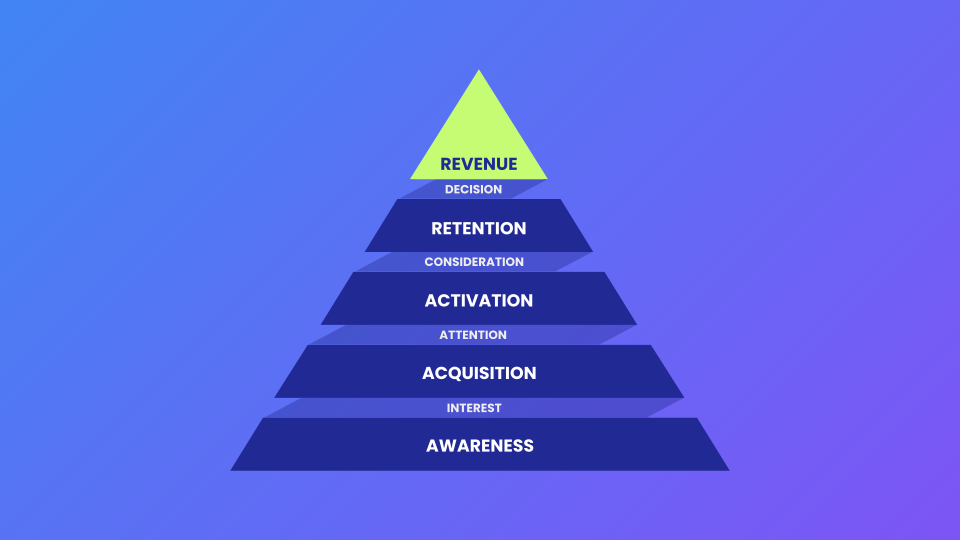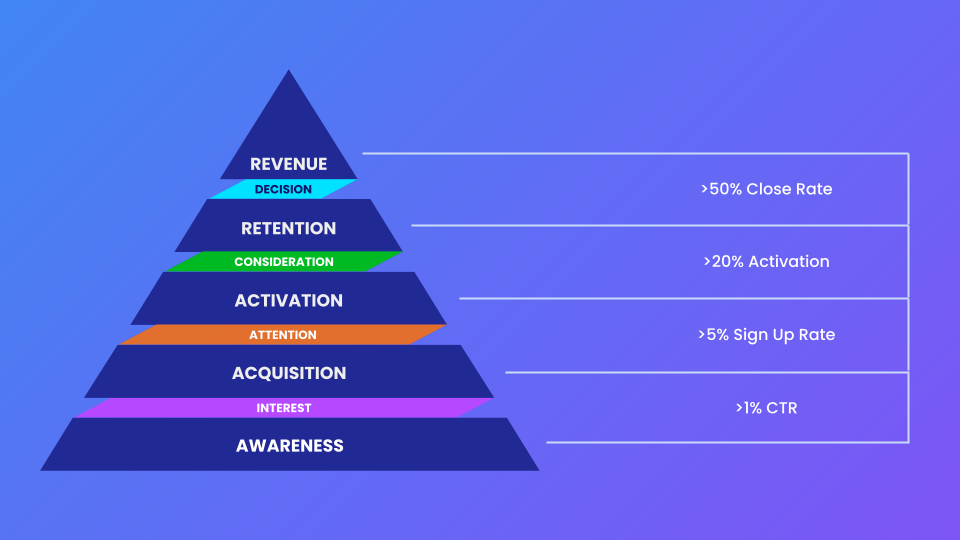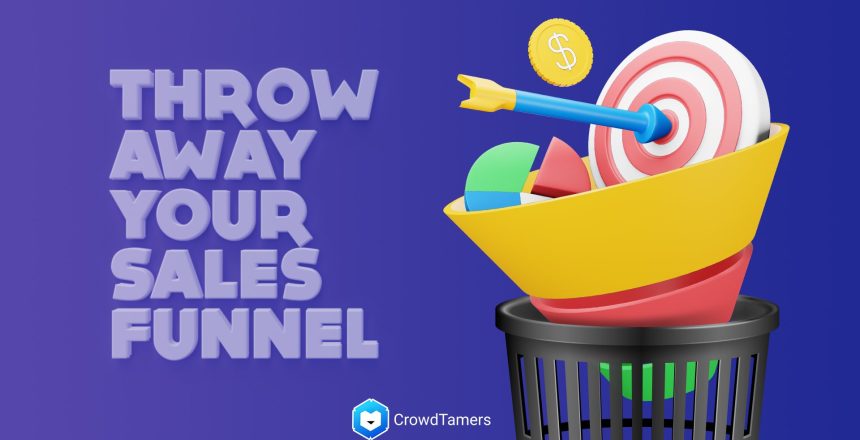Earlier this year, I wrote an article on how to use Pirate Metrics for your sales funnel for a great outlet called RevGenius.
In retrospect, about 60% of that article is wrong. You should throw away your sales funnel. Use this instead:

“Why that’s just a Pirate Metrics sales funnel turned upside down, Trevor!” I hear you say. I can see why you think that, but it’s something quite different.
Why the Sales Funnel Falls Short
Dave McClure’s classic Pirate Metrics funnel is a well-known way to approach the buyer’s journey.
I don’t like it.
This is because it has 2 problems:
- A sales funnel suggests that leads just kind of…fall from the top to the bottom with no work. Like a funnel.
- Literally 100% of what you pour into the top of a funnel comes out the bottom. That’s the whole point of a funnel. But that is not how the idea of a “sales funnel” works, which breaks the whole analogy. At best, you are constructing a series of crappy sieves.
Let’s come up with something a little clearer.
I like constructing a revenue pyramid from the bottom up.
Like any building, you must build the foundation before you get to the next stage, but it’s also noteworthy that you need to build each stage. They don’t magically happen. Instead, like the laborers in ancient Egypt of old, you’ll need to apply craft, intelligence, and diligence to assemble your pyramid, brick by brick.

I call this the Startup Launch Pyramid. It contains a step that Dave McClure didn’t include -awareness – and omits “referral” because that’s not really a step–it can happen at any time.
Build from the Ground Up: The Startup Launch Pyramid
Building any structure starts from the bottom up. You need a solid foundation before anything else. This Pyramid starts with awareness—getting people to know your product exists. Then, it moves up through acquisition, getting people to sign up; activation turning them into active users, retention, getting them to use your product or participate in your sales process long enough to start the context switch to using you instead of their current alternative; and finally revenue, making money from them.
This makes more sense because it’s about building step-by-step, not just expecting results to happen.
You know, like a funnel does.
Crossing the Gaps: Your Customer’s Journey
Look at that pyramid again. Wait. Zoom. Enhance.

What is “Interest” and “Attention” and the other words in between each of the levels of the pyramid?
Well, we are building the pyramid, yes. But we also need to make a ramp up the pyramid so people can go up it (unlike the actual ancient pyramids which are a complete OSHA nightmare for the workforce to ascend). Each of those gaps represents a step in the buyer’s journey up that pyramid.
It’s where you give up control and the buyer decides if they want to move further.
It’s not automatic; you need to help them over. Many people don’t choose to go further up the pyramid. Only a very few will reach the top (unlike, again, a stinkin’ funnel).
There are 4 gaps in the buyer’s journey—the 4 stages of their interest, and you need to make each step look as appealing as you can to the person who’s on the level below it to entice them up that pathway.
I call them, from the bottom up:
- The Interest gap.
- The Attention Gap
- The Consideration Gap, and
- The Decision Gap
The Marketer’s Gamble
Yes, these gaps are named, but they also represent a series of bets. “Can I hold your attention for this long?” Your goal is to get everyone from one level to the next.
- Interest (7 Seconds): This is the hook—your headline or ad that grabs their attention. This is 7 – 15 words and an intriguing premise.
- Attention (30 Seconds): The landing page visit. Reading the headline, skimming the page, maybe clicking on one link. A strong claim and a clear USP are key here.
- Consideration (10 Minutes): Sign up for a demo or book a sales call. If you don’t have your customer’s interest in 10 minutes after they’ve tried your product out or 10 minutes after your sales call has started, you will probably not be making any money today. You need to show them how your product or service does the thing that you promised them you’d do (back at the Interest gap) as fast as possible. If they see that you deliver what was on the tin, you might have them hooked.
- Decision (Hours to Days): The lead arms themselves with research, visits comparison sites, checks out pricing & feature tables, and then decides whether they are going to implement a new solution or if they’re just going to stick with the old way. Social proof, scarcity, urgency, case studies, or narrative proofs are all key here to show the lead that their life will be better after they’re a customer.
Metrics That Matter: The CrowdTamers Guarantee.
What if I could tell you that I can guarantee your business will be successful if you pay relentless attention to 4 numbers?
Just 4.
No need for crazy fancy dashboards. No 3,000g cell spreadsheets.
Just 4 numbers.

There are four key metrics you need to see of people crossing the 4 Gaps in your Pyramid that can mean that you’re going to make money:
- More than 1% of people who see your stuff should click on it (More than 1% of people cross the Interest gap).
- More than 5% of those who click should sign up (More than 5% of people cross the Attention gap).
- More than 20% of those who sign up should start using your product or attend your sales demo & be interested in hearing more(More than 20% of people cross the Consideration gap).
- And over 50% of those using it should end up paying you (More than 50% of people cross the Decision gap).
These aren’t just random numbers—they come from launching over 100 startups. If you can hit these, you’re on your way to a business that can keep going on its own.
There’s a caveat here.
You can’t spend too much for people to cross the Interest gap—I recommend a CPC of <1.3% of your average customer value—otherwise, this doesn’t work out at all. Because of that, if you’re running paid ads to fuel this, you want to find customers whose ACV is between $150 and $25,000. More than $25k, and you probably don’t have a large enough audience to make it work for you. Under $150 in ACV and your cost per click is probably going to be too high no matter how hard you try.
But if you’re the 78% of businesses whose ACV falls between those two numbers? Go crazy. I’m not saying this will make you a millionaire, but it’ll consistently return more money than you spent.
Wanna learn more? Wanna see how I do it in action? Sign up for my Go To Market Mastery Program today and I’ll show you how I do it in glorious Technicolor video + supporting docs and regular calls.



